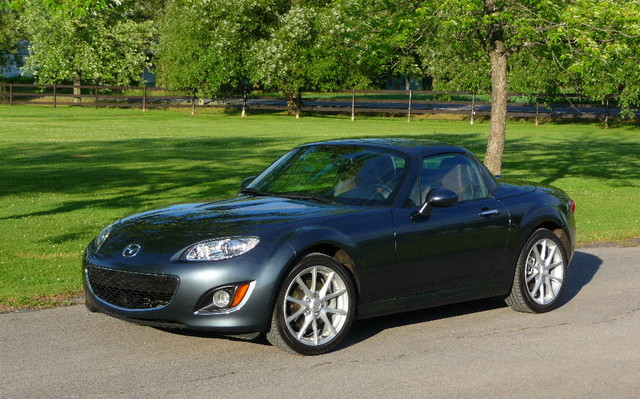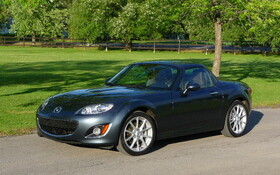2010 Mazda MX-5: Still a modern-day classic

| Strong points |
|
|---|---|
| Weak points |
|
Since its spectacular debut in 1989, this Mazda has been very popular. What’s more, after all the improvements, makeovers and modifications, the engineers have always been faithful to the original version, refusing to make it too big, too powerful or too expensive. They were true to the basic concept of an affordable roadster powered by an engine with decent power that is a lot of fun to drive. Furthermore, the asking price for this little wonder remains reasonable, but we’ll come back to that later.
So, after more than 30 years on the market, this Mazda is still a roadster with a classic look. Yet, it managed to evolve over the years and adapt to new evolutions in style while becoming more comfortable, too.
Intimate passenger compartment
I may as well tell you right away, if you like to keep your distance from others, you’re going to find the passenger compartment quite cramped. Then again, it isn’t a torture chamber either. Even someone who’s 6 feet tall and weighs 200 pounds will be able to ride inside without any problems and without feeling confined. However, elbows are going to touch when two large people are on board. Overall, the head and leg room is good, at least for large people with proportionate torsos and legs. On the other hand, you’ll have to be very flexible to be able to activate the fuel tank flap release, which is located on the rear wall of the cabin, hidden on the side of a cubby. Note that the finish is nice and the quality of the materials is good.
The MX-5’s dashboard has evolved over the years. From a near carbon copy of a British sports car, it has become something more modern, but it’s still reminiscent of those classic little English cars. The two-tone dashboard, with its black upper part and bronze-coloured façade, has a very good colour scheme. Most of the controls, both climate and audio, are located in a vertical console whose rounded top breaks the monotony of the dashboard. The circular air vents are efficient and easy to close using a central button.
The driver’s seat is very comfortable and has adequate lateral support. The indicator dials are encircled by a band of the same colour as the dashboard, which helps accentuate the impact of the black numbers on the white background. The three-spoke steering wheel with brushed aluminium accents, or at least plastic that looks like brushed aluminium. There are also audio and cruise control commands on the steering wheel.
Even with the automatic
This text is the fruit of two successive test drives. First of the MX-5 with an automatic transmission and another with a six-speed manual transmission. There’s no denying that the manual, with its well-selected gear ratios and its very precise stick shift, is a lot more fun to drive. It has nothing in common with the six-speed transmission offered a few years ago, which had a sixth gear that was very hard to engage, as though there wasn’t enough space in the gearbox. Thus, it’s a pleasure to shift from gear to gear to get the most out of this 2.0-litre, 167-hp four-cylinder engine. You should also keep in mind that, if you opt for the base model, namely the GX version, you’ll get a five-speed manual transmission. To have one more gear, you’ll have to choose the GS, a version in between the GX and the GT. The automatic is not available with the GX, but you can get it on option on the GS and GT. It’s a six-speed too, and is paired with the same 2.0-litre engine, but it only has 158 horsepower. Note that Mazda’s engineers also reduced the power with the automatic transmission version of the RX-8.
On paper, an automatic MX-5 seems to be a very attractive model. On the road, it’s even better than we expected. In town and on the highway, we left all the work to the transmission and we must admit that the results were very conclusive. Then, if you want a more inspired ride, you can put the transmission in manual mode and shift using the stick shift. Moreover, shifters mounted behind the steering wheel help up- and downshift with ease, but this is a little ho-hum and you can bet that many will choose to play with the stick shift.
The automatic is a little slower than the manual, but once you’re behind the wheel, the sensations are almost identical. Regardless of the model you choose, the steering is precise, it’s predictable in turns, and the suspension is comfortable for a car with a short wheelbase. Overall, this Mazda hasn’t lost any of its charm and is still fun to drive. Its performances are decent with a 0-100 km/hr time of a little less than eight seconds, but its feedback from the road and agility above all are enchanting.
Both of the models that we test drove were equipped with a power retractable top. Lowering or raising this roof takes a few seconds. First, you release the hook holding the roof in the passenger compartment and then you push a button on the upper part of the vertical console. In less than 20 seconds, you’re in the great outdoors. Want to be where it’s warm and dry? Do the same thing in reverse order. And what’s even more impressive is that this folding hard top doesn’t encroach upon the trunk in the least. The engineers put a receptacle for the three folded down panels behind the passenger compartment. It’s ingenious and practically magical. As for the trunk, it’s sufficiently deep and spacious for the size of the vehicle.
The only major complaint that we can lay against the former Miata and current MX-5 is the fact that the more exclusive versions are very expensive. You be the judge: a manual GX with climate control goes for an appealing suggested retail price of $30,190, while the manual GS base model goes for $33,495. The GT with manual transmission has a $39,999 price tag, but it comes factory standard with the retractable metal top, which is offered on option on the GS for $2,295. That should put things in perspective.
But regardless of the price of the model you choose, roadsters that offer this much fun for the price are few and far between.











